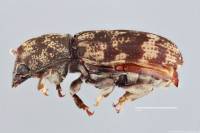Go to Encyclopedia of Life...
Holotype (variation in parentheses); length, head excluded, 6.5 (5.0-7.25) mm; form elongate, parallel-sided, evenly convex; derm varying shades of reddish-brown, dorsal pubescence mixed dark brown and pale straw, the venter and legs slightly more gray. Head: with a weak median carina on rostral apex; entire face densely punctate, the intervening areas convex and forming fine longitudinal reticulate rugae; scattered pale pubescence vaguely concentrated around eyes; antennae very short, not reaching humerae (even with head deflexed), first 2 segments thicker than those following, II slightly longer than III, III to VIII progressively shorter, club abrupt, asymmetrical, almost as long as III to VIII combined. Prothorax: widest at anterior third; evenly convex; transverse carina entire, almost basal, meeting lateral carina in an abrupt curve, the resulting angle about 90°, lateral carina continuous to apex where it protrudes as a small flattened shelf-like tooth; dorsum densely and irregularly punctate, most concentrated at basal third and laterally where punctures are separated by a puncture diameter or less, least concentrated and obscure on apex; entire prosterum with large punctures except along both sides of the pleural (supra-coxal) suture, the suture not quite extending to the lateral carina; no deep groove along the ventral apical margin; intercoxal process with a thick curved ridge between the coxae, no long transverse post-coxal ridge nor lamella. Scutellum: small, cordate, flush with elytral margin, densely pale pubescent. Elytra: elongate, parallel-sided, base almost straight, slightly wider than prothoracic base; raised basal margin continuous around prominent, obtusely-angled shoulders; striae barely impressed except the apical portion of the first, punctures small and deep, spaced differently on each stria but usually separated by more than the diameter of a puncture; interspaces faintly convex; extreme apex with just a hint of a marginal swelling beside the sutural angle; pale pubescence most evident in irregular spots on basal third, and in larger patches above apical declivity, these incomplete across the suture. Pygidium: with wide median line and narrow periphery reddish brown, remainder gray pubescent; disc with many small very shallow punctures. Abdomen: with first 4 sternites each deeply and closely punctate along anterior margin, fifth sternite with traces of basal punctures. Pterothorax: with large deep punctures; metassternum with raised rim but no deep groove along hind margin of mesocoxae, and a midventral groove accentuated by a deep elongate pit, the groove ending in another pit between the metacoxae. Legs: with femora unicolored, short, greatly swollen, faintly and shallowly punctate; tibiae unicolored, short, flattened, angulate, the apices (especially middle and hind pair) almost rectangular in cross section; tarsi unicolored, short, apical half of first segment convex, of second segment concave, third short, almost hidden from above, deeply immersed in the second and with the lobes short and close together, fourth vertical, small, fifth longer, depressed, widest in the center then slightly narrowed to apex, claws long with a strong antemedian tooth. Male: metasternum without paired tubercles anterior to the hind leg insertion; abdominal sternites II, III, IV each with a small median tuft of fine golden bristles; mid tibia with a small apical incurved tooth on lower margin; ventral apex of hind tibia and first two tarsal segments with a few long erect fine golden bristles.












